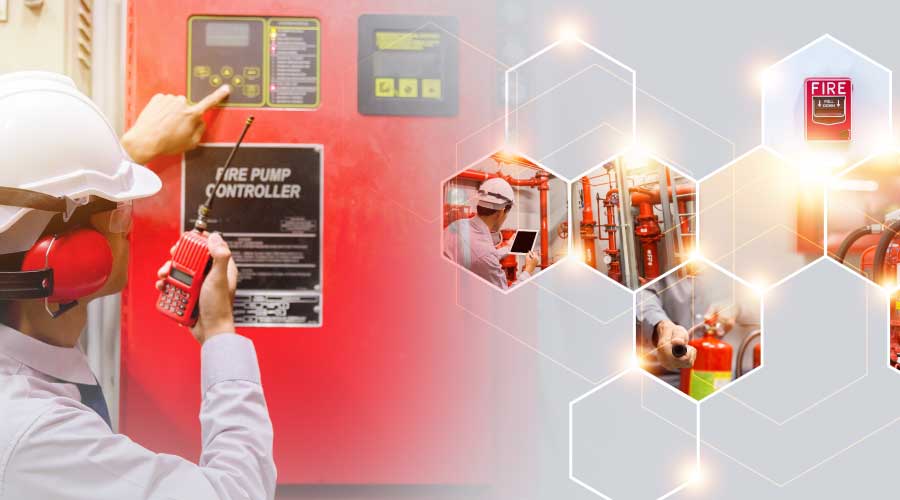A Surge in Electric Vehicles Brings Fewer but Harder Fires to Fight
Facilities managers will play a vital role in fire prevention and firefighting in connection with an increased presence of lithium-ion batteries.
By Daniel Colombini and Vinod Palal, Contributing Writers
The United States has set a goal that by 2030 half of all new vehicles sold in the nation will be zero-emissions vehicles, including electric or plug-in hybrids. Key to achieving that goal is having sufficient infrastructure in place to support charging those vehicles. Facilities managers will play a vital role in implementing that infrastructure and addressing related needs, including fire prevention and firefighting in connection with an increased presence of lithium-ion batteries.
Fortunately, few electric vehicle fires occur without prior damage to the lithium-ion batteries. Still, those fires are harder to fight than fires in conventional vehicles.
Creating the infrastructure is already underway. The U.S. Infrastructure Investment and Jobs Act of 2021 includes $7.5 billion to build out the first-ever national network of electric vehicle (EV) chargers, and the Inflation Reduction Act of 2022 offers expanded federal tax credits to persuade more businesses to add chargers.
Yet much more needs to unfold. The ultimate network will include a mix of EV charging at home (for daily use), on the open road (for long-distance travel), at office, distribution, and other institutional facilities (for commuting and fleet needs), and at restaurants and other consumer-service locations (for additional convenience).
Within those commercial settings, facilities managers in office, distribution, and other institutional settings have a particular advantage: the people using their facilities are typically known to them. Facilities managers can, therefore, survey those individuals to determine at what pace they will be transitioning to electric vehicles – and then plan to meet the known needs.
That’s a great advantage, because a major challenge in creating the infrastructure nationwide is the chicken-and-egg problem of which comes first: sufficient sales of electric vehicles or the supply of needed chargers. As The Wall Street Journal states, “The government is pouring billions of dollars into developing a national highway charging network. But businesses aren’t sure how they will make money, and the nascent industry looks messy.”
For facilities managers in office, distribution, and other institutional settings, the future in this respect can largely be predicted. Surveyed needs will address two primary categories: electric cars – largely serving office workers, employees, and other tenants – and commercial fleets: cars, trucks, and other vehicles owned by the facilities or their institutional clients.
Addressing the needs of electric non-fleet cars is relatively straight-forward, although the pace could speed up quickly. Once the number of needed charging stations can be anticipated, infrastructure improvements can be planned and made. The existing electrical infrastructure can be evaluated, needed improvements identified and designed, costs and incentives assessed, and phased plans put in place.
The pace will have to be closely monitored. S&P Global Mobility predicts that electric vehicle market share for new vehicles is likely to reach 40% by 2030. The US Bureau of Labor Statistics reports that more optimistic projections foresee electric vehicle sales surpassing 50 percent by 2030. KPMG’s Consumer Pulse Summer 2023 survey reveals, according to InsideEVs, that nearly half of the gas and diesel vehicle owners in the nation are considering switching to hybrid or electric vehicles.
The big difference with regard to fires in electric vehicles is not that they are more common; fires in electric vehicles are far less common, even when controlling for the number of sales. But fires in electric vehicles are much harder to fight, and that should be taken into account when planning for infrastructure improvements.
Researchers from Auto Insurance EZ analyzed data from the National Transportation Safety Board and the US Bureau of Transportation Statistics. They found that hybrid vehicles have the most fires per 100,000 sales at 3,474.5 fires, gas vehicles were next at 1,529.9 fires, and electric vehicles posed the least concern at just 25.1 fires.
“As DriveElectricColorado reports, “Lithium-ion (Li-ion) battery fires are different from gasoline fires as they take time to achieve the necessary heat to ignite (called thermal runaway), whereas gasoline ignites immediately when it encounters a spark or flame. Because of this, Li-ion batteries have a significantly lower risk of causing a fire or explosion. When they do, it is usually a result of significant external damage. Battery packs in electric vehicles rarely encounter serious damage, and it is often the result of a highly unusual or severe accident.”
Yet when lithium-ion battery fires do occur, they are much more difficult to extinguish. As The Boston Globe reports, “When a (lithium-ion) battery fire starts, it can quickly spread between battery cells, keeping the fire ablaze. So, when EV fires do occur, they burn hotter than gas fires and are more prone to re-igniting. And unlike gas fires, lithium-ion battery fires don’t require outside oxygen to burn, making them harder to extinguish.”
Autoweek warns, “Lithium-ion battery fires can take tens of thousands of gallons of water to extinguish. …. Fire departments aren't always equipped with trucks and other gear to deal with that. The Boston Globe adds, “Also missing from most fire departments: EV-specific fire suppressants. Powders made of graphite or sodium chloride can more effectively quell lithium-ion battery fires than water … but right now, firehouses generally don’t have those materials on hand.”
At most institutional facilities, having sufficient water would not be a problem, although it easily could be in areas of the country that have suffered from recent water shortages. Increasingly, prioritizing EV-specific fire suppressants should be evaluated.
Fires in electric vehicles also require more suppressant than those in conventional cars, because the suppressant must be applied until all the energy is gone. In addition, each model of electric vehicle has its own recommended approach to firefighting, and firefighting personnel may not be familiar with them. Educating those personnel, whether normally on-site or at nearby fire stations, is vital. It’s especially important that facilities managers be aware of different approaches for different cars – to ensure that someone on-site has that information at hand.
Fires caused by electric scooters and bikes are a greater concern. As Autoweek reports, “In reality, uncertified batteries that are being charged without supervision or not to the manufacturer's specifications are the common thread in most of these fires. Due to the high cost of legitimate battery packs and the ubiquity of two-wheeled electric vehicles as urban delivery tools, many delivery workers are compelled to purchase cheaper, unregulated batteries and continue recharging them past their prime.”
Institutional fleets raise a separate set of infrastructure concerns, about which we are asked by clients regularly. Those concerns center on three considerations: first, the fleet is typically charged only on-site, as distinct from the electric vehicles of commuters that may regularly be charged at home; second, trucks and buses have more extensive demands than cars and may all need to be charged on the same schedule – with all school buses, for instance, ready for pickup and drop-off at the same time each day; third, certain equipment must be constantly available in emergencies, such as snowstorms, where all equipment may be activated at once and required to offer 24-hour coverage.
The demands on the infrastructure are also greater. Refueling speeds can be crucial to efficient use of vehicles, with higher-level chargers needed. Level 3 chargers, for instance, can provide three to 20 miles of range per minute, compared to a Level 1 residential charger’s three to five miles of range per hour. Level 2 chargers offer around 32 miles of range per hour.
At present, the cost of electric trucks and buses is still prohibitive for most uses, but those costs will likely decline over time, as demand and competition increase. That trend must thus be monitored as well.
The fire-related concerns of electric trucks and buses are no different overall than for electric cars. Still, the larger the vehicle, the larger the battery, and so the larger any fire could be. Here, too, the need to know the recommendations for firefighting in any vehicle are vital.
Electric vehicles offer enormous environmental advantages that the world desperately needs. The predictions of dramatic growth of electric vehicles are, therefore, very encouraging. Keeping them charged will be the challenge, and facilities managers will be crucial to making that happen.
The authors are Principals at the New York City-based consulting engineering firm Goldman Copeland, where Dan Colombini is Director of Plumbing and Fire Protection and Vinod Palal is Senior Electrical Engineer.
Related Topics:












